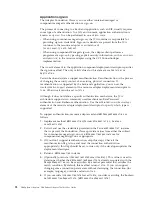
generate a timestamp to identify an event, producing an identifier such as
MyAdapterName
_06139833001005.
Object Key
Each event should contain enough key information to enable the adapter
event-retrieval mechanism to locate and retrieve the full entity in the EIS for which
this event was originally recorded. The structure and content of this key is up to
you.
For reference, a key is typically comprised of easily-parsed values such as
name-value pairs. For example, Customer_ID=123 or, for a composite key,
Model=Widget;Color=CanaryYellow.
Business Object Name
Since the EIS entity identified in each event is converted to a business object
instance, the type of the business object must either be specified or derivable at run
time by the event-retrieval mechanism.
The most straightforward approach is to include the business object name value in
the event record. Specifically, the business object graph type should be included;
for example, CustomerBG or OrderBG.
Note:
The namespace, which is also required for business object creation, need not
be included in the event; the namespace is user-defined and should be retrieved by
the adapter from the adapter ActivationSpecWithXid instance.
If, as an adapter developer, you choose to derive the business object graph type,
you are strongly advised against mandating any specific EIS entity name to
business object type mapping schemes. Business object properties and names are
unreliable because they can be modified by users. To avoid such problems,
adapters should always process business objects using metadata.
Verb
The verb should reflect the operation that this event represents. For example, if this
event reflects the creation of an entity in the application, the verb would be Create.
This value should be one of the standard verbs used by adapters (including Create,
Retrieve, Update, Delete) and specified in the business object generated for the
event. When properly specified in the business object, the verb allows consumers
of the business object event to determine what action to take on the event.
Note:
The default function selector implementation (WBIFunctionSelector) uses the
verb passed in the event business object to determine the appropriate SCA EIS
import operation. Be sure that verbs used here correspond to the operations
defined by your adapter enterprise metatdata discovery implementation.
Timestamp
The Foundation classes use the timestamp to ensure proper ordering of events. For
example, use of a timestamp prevents an event describing the deletion of an Order
from being published before an event describing the creation of that same Order.
The timestamp should provide detail sufficient to distinguish events occurring
close in time.
WebSphere Adapter development overview
83
Содержание WebSphere Adapters
Страница 1: ...WebSphere Adapters WebSphere Adapter Toolkit User Guide Version 6 Release 2 Version 6 Release 2...
Страница 2: ......
Страница 3: ...WebSphere Adapters WebSphere Adapter Toolkit User Guide Version 6 Release 2 Version 6 Release 2...
Страница 6: ...iv WebSphere Adapters WebSphere Adapter Toolkit User Guide...
Страница 211: ...7 Start UTC using the Run universal test client option WebSphere Adapter development overview 205...
Страница 220: ...214 WebSphere Adapters WebSphere Adapter Toolkit User Guide...
Страница 224: ...218 WebSphere Adapters WebSphere Adapter Toolkit User Guide...
Страница 225: ......
Страница 226: ...Printed in USA...
















































